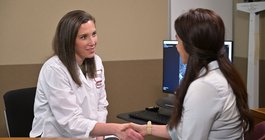
March 25, 2024
Each year, the nation’s 55 Poison Control Centers receive 1.2 million calls stemming from accidental poisonings involving children aged five and under. Most of these incidents occur at home and are caused by common household items ranging from medications to household cleaners to poisonous houseplants.
Here are some of the risks to be mindful of in your home as well as some steps you can take to keep your children safe.
If you take medicines regularly, don’t leave them out between doses. Medications should be kept in their original containers with child safety caps and stored in a lockable box or cabinet with shelves that are too high for your children to reach. For an added layer of safety, keep track of how many pills are left in each container. That way, you’ll know how many you’ll need to pick up if there’s a spill.
When a medication expires or you stop taking it, get rid of it. If it shouldn’t be flushed down the toilet and you can’t find a place that will take it, put the medication in a bag and dispose of it in a secure outdoor trash can.
You should also avoid taking medications in front of your child because they may try to imitate you by taking those medicines themselves. And never try to get your child to take a medication by telling them it’s candy. Read and carefully follow the directions included with your child’s medication. If it comes with a dosing cup or syringe, use that rather than a spoon to make sure the correct dosage is taken. If the directions require you to give them the medicine at night, turn on the light to be sure you’re giving your child the right medicine and dosage.
Household cleaners, art supplies, cosmetics, and other personal care products should be stored out of your children’s sight and reach inside a cabinet, cupboard, closet, or box you can lock. Never leave these products unattended and immediately put them away when you’re done. For household cleaners, you may want to consider using non-toxic versions that can be made using common products.
Search your home and collect any items that may contain button batteries. They include, but aren’t limited to:
• Remote controls
• Singing greeting cards
• Digital scales
• Watches
• Hearing aids
• Thermometers
• Toys
• Calculators
• Key fobs
• Flameless or tea light candles
• Flashing holiday jewelry and decorations
These items should be kept out of sight from your children. If that’s not possible for some items, make sure your children can’t access them when you’re not in the room.
Carbon monoxide is a colorless, odorless gas produced by burning carbon-based fuels. Exposure to this dangerous gas leads to more than 400 deaths and about 50,000 visits to the emergency room each year. To protect your children (and the rest of your family) from carbon monoxide poisoning, have all fuel-burning appliances and home heating systems inspected annually. You should also never burn charcoal or operate a gasoline-powered generator inside your home.
Install carbon monoxide detectors on each floor in your home, in bedrooms and kitchens, and near fuel-burning appliances, such as furnaces or water heaters. Change their batteries twice a year or use devices with sealed 10-year batteries.
If your home was built before 1978, check it for lead-based paint. If you find it, test your child for lead exposure and hire a professional who can limit how much you and your family are exposed to it until it’s safely removed. For added safety, routinely check recalls.gov for more information on recalls of products containing lead.
Indoor plants can be a healthy addition to your home, but some can pose a serious threat if they’re mistakenly eaten. While the best way to prevent an accident is to only use fake plants, any live ones you do have should be kept out of your child’s reach. It’s also a good idea to familiarize yourself with each plant’s botanical and common name, the toxic part of the plant, and any symptoms of poisoning you should watch out for.
Your yard can also contain hazardous plants, so be sure to identify and remove any potentially dangerous ones from your property. It’s also important to educate your kids about the dangers of eating unknown plants or mushrooms and supervise them while playing outside. And if you use fertilizers, pesticides, or any other gardening products, keep them in a secure location.
If you’re drinking an alcohol beverage, always keep an eye on your glass to make sure your child cannot drink it when you’re not looking. Bottles of alcohol should be kept it in a locked cabinet, cupboard, or closet that children can’t access.
Keep the Poison Control Hotline number (800-222-1222) where you can access it when needed. The same goes for the National Battery Ingestion Hotline number (800-498-8666).
You can also download the Poison Control app and bookmark poisonhelp.org, which is the official website of the 55 U.S. Poison Centers.